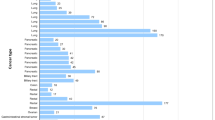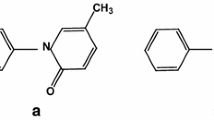Abstract
Purpose
Previous experience with perillyl alcohol (POH) was with a formulation of 500-mg capsules each containing 250 mg POH and soybean oil. This formulation resulted in the ingestion of large amounts of soybean oil (>10 g/day). Dose-limiting toxicities (DLT) were primarily gastrointestinal. Prior studies also showed no further increase in POH metabolite concentrations with doses of >1600 mg/m2. Therefore, a new formulation of POH was developed (700 mg containing 675 mg POH) in an effort to improve dose and metabolite concentrations delivered and toxicity encountered with chronic dosing.
Experimental design
Eligible patients had refractory solid malignancies. Dose escalation occurred in cohorts of three at the dose levels/dose of 1350 mg, 2025 mg, 2700 mg, 3375 mg and 4050 mg, administered orally four times a day in a 28-day cycle.
Results
A group of 19 patients were enrolled. One DLT occurred at dose level 5. This cohort was expanded to six patients, and no further DLT occurred. The maximum tolerated dose was not reached. The predominant toxicity was gastrointestinal. Nausea and vomiting occurred in 63% of patients (12/19, grade 1 in 10). The same proportion of patients (12/19) experienced heartburn and indigestion, primarily grade 1. Although the side effects were mild in nature, three patients withdrew from treatment, citing intolerable gastrointestinal toxicity. The AUCs of POH metabolites did not appear to increase from level 1 to level 2 or change significantly from day 1 to day 29. Inter- and intrapatient variability in metabolite levels was observed.
Conclusions
This reformulation of POH appears to be an improvement upon the prior formulation, by reducing the number of capsules ingested and the degree of gastrointestinal toxicity per dose. It does not appear to offer any metabolite pharmacokinetic advantage. A dose of 2050 mg administered four times daily was easily tolerated. Higher doses can be administered but with increasing gastrointestinal toxicity that limits compliance.
Similar content being viewed by others
Abbreviations
- AUC:
-
Area under the curve
- DHPA:
-
Dihydroperillic acid
- DLT:
-
Dose-limiting toxicity
- IGF:
-
Insulin-like growth factor
- M6P:
-
Mannose-6-phosphate
- MTD:
-
Maximum tolerated dose
- PA:
-
Perillic acid
- POH:
-
Perillyl alcohol
- TGF:
-
Transforming growth factor
- ULN:
-
Upper limit of normal
References
Bailey HH, Levy D, Harris LS, Schink JC, Foss F, Beatty P, Wadler S (2002) A phase II trial of daily perillyl alcohol in patients with advanced ovarian cancer: Eastern Cooperative Oncology Group Study E2E96. Gynecol Oncol 85:464–468
Chander SK, Lansdown AGB, Luqmani YA, Gomm JJ, Coope RC, Gould MN, Coombes RC (1994) Effectiveness of combined limonene and 4-hydroxyandrostenedione in the treatment of NMU-induced rat mammary tumors. Br J Cancer 69:879–882
Crowell PL (1997) Monoterpenes in breast cancer chemoprevention. Breast Cancer Res Treat 46:191–197
Crowell P, Chang RR, Ren Z, Elson CE, Gould MN (1994) Selective inhibition of isoprenylation of 21–26 kda proteins by the anticarcinogen D-limonene and its metabolites. J Biol Chem 266:17679–17685
Crowell PL, Ren Z, Lin S, Vedejs E, Gould MN (1994) Structure-activity relationships among monoterpene inhibitors of protein isoprenylation and cell proliferation. Biochem Pharmacol 147:1405–1415
Elegbede JA, Elson CE, Qureshi A, Tanner MA, Gould MN (1984) Inhibition of DMBA-induced mammary cancer by the monoterpene d-limonene. Carcinogenesis 5:661–664
Gibaldi M, Perrier D (1982) Pharmacokinetics, 2nd edn, Dekker, New York
Haag JD, Gould MN (1994) Mammary carcinoma regression induced by perillyl alcohol, a hydroxylated analog of limonene. Cancer Chemother Pharmacol 4:477–483
Haag JD, Lindstrom MJ, Gould MN (1992) Limonene induced regression of mammary carcinomas. Cancer Res 52:4021–4026
Homburger F, Trigge A, Boger E (1971) Inhibition of murine subcutaneous and intravenous benzo(rst)pentaphene carcinogenesis by sweet orange oils and d-limonene. Oncology 25:1–20
Hudes G, Szarka CE, Adams A, Ranganathan S, McCauley RA, Weiner LM, Langer CJ, Litwin S, Yeslow G, Halberr T, Qian M, Gallo JM (2000) Phase I pharmacokinetic trial of perillyl alcohol in patients with refractory solid malignancies. Clin Cancer Res 6:3071–3080
Jirtle RL, Haag JD, Ariazi EA, Gould MN (1993) Increased levels of M6P/IGF-II receptor and TGF-β II levels during monoterpene induced regression of mammary tumors. Cancer Res 53:3849–3852
Lantry LE, Zhang Z, Crist KA, Wang Y, Hara M, Zeeck A, Lubet RA, You M (2000) Chemopreventive efficacy of promising farnesyl transferase inhibitors. Exp Lung Res 26:773–790
McNamee D (1993) Limonene trial in cancer. Lancet 342:801
Meadows SM, Mulkerin D, Berlin J, Bailey H, Kolesar J, Warren D, Thomas JP (2002) Phase II trial of perillyl alcohol in patients with metastatic colorectal cancer. Int J Gastrointest Cancer 32:125–128
Mills JJ, Chari RS, Boyer IJ, Gould MN, Jirtle RL (1995) Induction of apoptosis in liver tumors by the monoterpene perillyl alcohol. Cancer Res 55:979–983
Phillips LR, Malspeis L, Supko JG (1995) Pharmacokinetics of active drug metabolites after oral administration of perillyl alcohol, an investigational antineoplastic agent, to the dog. Drug Metab Dispos 23:676–680
Reddy BS, Wang C-X, Samaha H, Lubet R, Steele VE, Kelloff GJ, Rao CV (1997) Chemoprevention of colon carcinogenesis by dietary perillyl alcohol. Cancer Res 57:420–425
Ripple GH, Gould MN, Stewart JA, Tutsch KD, Arzoomanian RZ, Alberti D, Feierabend C, Pomplun M, Wilding G, Bailey HH (1998) Phase I clinical trial of perillyl alcohol administered daily. Clin Cancer Res 4:1159–1164
Ripple GH, Gould MN, Arzoomanian RZ, Alberti D, Feierabend C, Simon K, Binger K, Tutsch KD, Pomplun M, Wahamki A, Marnocha R, Wilding G, Bailey HH (2000) Phase I clinical and pharmacokinetic study of perillyl alcohol administered four times a day. Clin Cancer Res 6:390–396
Shi W, Gould MN (1997) The anticancer monoterpene perillyl alcohol causes a decrease in cellular cyclin D1 levels contributing to an early G1 arrest in mammary cells. Proc Am Assoc Cancer Res 38:263
Yoshiko S, Shigeki M, Gould MN (1999) Induction of AP-1 activity by perillyl alcohol in breast cancer cells. Carcinogenesis 20:1957–1961
Author information
Authors and Affiliations
Corresponding author
Additional information
This work was supported by University of Wisconsin General Clinical Research Center Grant M01 RR 03186.
Rights and permissions
About this article
Cite this article
Morgan-Meadows, S., Dubey, S., Gould, M. et al. Phase I trial of perillyl alcohol administered four times daily continuously. Cancer Chemother Pharmacol 52, 361–366 (2003). https://doi.org/10.1007/s00280-003-0684-y
Received:
Accepted:
Published:
Issue Date:
DOI: https://doi.org/10.1007/s00280-003-0684-y




